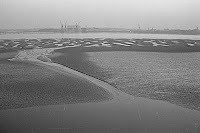Heather at Worms Head
Originally uploaded by Nevoir.
It can be difficult to convey the same sense of depth that you saw when taking a picture to the viewer.
In the photo above the subject really is Worms head which is the outcrop that pokes out into the sea from east side of Rhossili Bay.
I wanted to draw the viewer through the picture by layering colour across the bottom third of the frame. The mound in the middle ground was perfectly shaped to point out Worms Head in the distance.
The result is designed to guide the eye through the image to the subject, to deliberately influence what you look at and in which order you look at it.
The image above doesn't use a classic leading line but it uses the same principle. Typically leading lines in landscape photography are provided by rivers, railway lines and even logs and branches but really you can use whatever you can find.
We use them as a focal point that directs interest through the frame to your subject. They don't have to be straight, they just need to draw your eye and take you off into the image.
Essentially they are a compositional trick to add structure to an image, but critically they are a way of focussing the viewers gaze on the subject of the image as well as adding depth.
Some examples of leading lines from more traditional to the more abstract can be seen below:
 A classic use of a leading line guiding the eye up to the Arc de Triomphe with some added jazz courtesy of the long exposure.
A classic use of a leading line guiding the eye up to the Arc de Triomphe with some added jazz courtesy of the long exposure. Another classic leading line, this time with a bit of a curve for added interest all leading to the old Cammel Laird ship yard on the banks of the mersey.
Another classic leading line, this time with a bit of a curve for added interest all leading to the old Cammel Laird ship yard on the banks of the mersey. A less conventional leading line but the same effect of giving the image depth is achieved. In this example the sense of depth is amplified by the shallow depth of field.
A less conventional leading line but the same effect of giving the image depth is achieved. In this example the sense of depth is amplified by the shallow depth of field.Try and look out for objects that will provide leading lines and place them in the foreground of your pictures and see how compositionally your pictures improve.
No comments:
Post a Comment